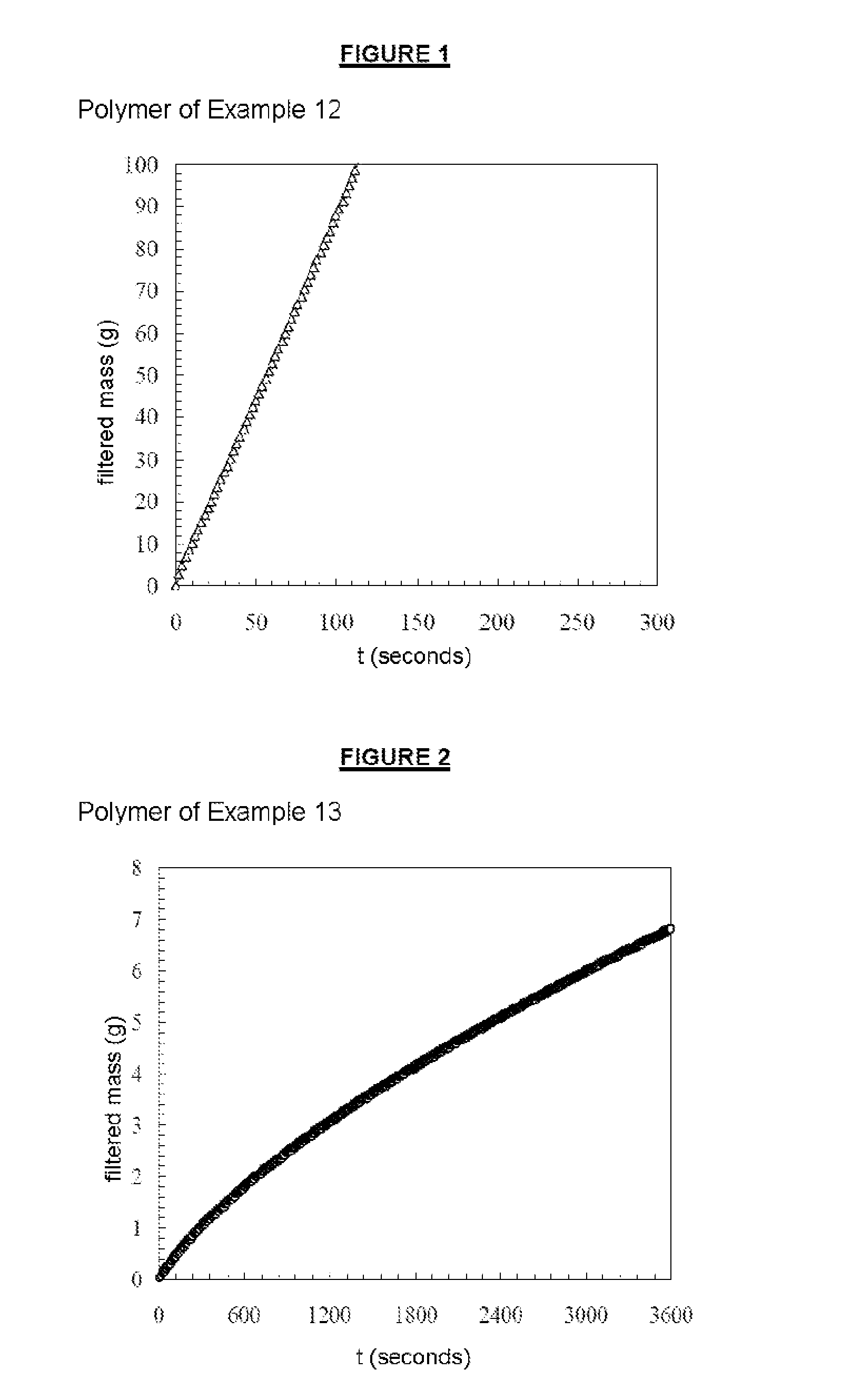Preparation of Amphiphilic Block Polymers by Controlled Radical Micellar Polymerisation
a technology of amphiphilic block and controlled radicals, which is applied in the direction of drilling compositions, chemistry apparatuses and processes, etc., can solve the problems of high non-homogeneous size of polymer chains, erratic polymerization of hydrophilic monomer units, and inability to control the microstructure of the polymer obtained, so as to reduce the amount of stabilizing surfactants used.
- Summary
- Abstract
- Description
- Claims
- Application Information
AI Technical Summary
Benefits of technology
Problems solved by technology
Method used
Image
Examples
examples
[0210]In the examples that follow, the synthesis of the polymers was performed using:[0211]a solution A comprising a living poly(acrylamide) prepolymer P1, prepared under the conditions of step (E0);[0212]a solution B which is a micellar solution of lauryl methacrylate (LMA) and of sodium dodecyl sulfate (SDS);[0213]a solution C which is a micellar solution of lauryl acrylate (LA) and of sodium dodecyl sulfate (SDS);[0214]a solution D which is a micellar solution of laurylmethacrylamide (LMAM) and of sodium dodecyl sulfate (SOS); or[0215]a solution E which is a micellar solution of LMAM and of sodium dodecyl sulfate (SDS),
prepared under the following conditions:
[0216]Solution a Containing the Prepolymer P1:
[0217]40 g of an aqueous 50% acrylamide solution (free of copper), 29.9 g of distilled water, 8.25 g of O-ethyl-S-(1-methoxycarbonylethyl)xanthate (CH3CH(CO2CH3))S(C═S)OEt, 26.6 g of ethanol and 0.537 mg of initiator V-50 (2,2′-azobis(2-methylpropionamidine) dihydrochloride) were ...
example 1
Poly(Acrylamide / LMA) 97.5 / 2.5 mol % nH 6.3 Mnth 148 000 g / mol
[0256]50 g of solution B, 13.08 g of acrylamide (aqueous solution at 50% by mass), 0.088 g of Solution A and 3.14 g of ammonium persulfate (aqueous solution at 0.5% by mass) were placed in a 250 mL round-bottomed flask, at room temperature (20° C.). The mixture was degassed by sparging with nitrogen for 30 minutes. 3.138 g of sodium formaldehyde sulfoxylate in the form of an aqueous solution at 0.5% by mass were added to the medium, in a single portion. This aqueous solution of sodium formaldehyde sulfoxylate was degassed beforehand by sparging with nitrogen.
[0257]The polymerization reaction was then left to proceed with stirring for 24 hours at room temperature (20° C.).
[0258]After the 24 hours of reaction, 98% conversion was obtained (determined by 1H NMR).
[0259]The gel thus obtained was subjected to a basic hydrolysis. 2 g of gel and 8 g of distilled water were placed in a 100 ml round-bottomed flask at room temperature...
example 2
Poly(Acrylamide / LMA) 97.5 / 2.5 mol % nH 6.3 Mnth 740 000 g / mol
[0261]50 g of solution B, 13.08 g of acrylamide (aqueous solution at 50% by mass), 0.018 g of Solution A and 3.14 g of ammonium persulfate (aqueous solution at 0.5% by mass) were placed in a 250 mL round-bottomed flask, at room temperature (20° C.). The mixture was degassed by sparging with nitrogen for 30 minutes. 3.138 g of sodium formaldehyde sulfoxylate in the form of an aqueous solution at 0.5% by mass were added to the medium, in a single portion. This aqueous solution of sodium formaldehyde sulfoxylate was degassed beforehand by sparging with nitrogen.
[0262]The polymerization reaction was then left to proceed with stirring for 24 hours at room temperature (20° C.).
[0263]After the 24 hours of reaction, 98% conversion was obtained (determined by 1H NMR).
[0264]The gel thus obtained was subjected to a basic hydrolysis. 2 g of gel and 8 g of distilled water were placed in a 100 ml round-bottomed flask at room temperature...
PUM
| Property | Measurement | Unit |
|---|---|---|
| Amphiphilic | aaaaa | aaaaa |
| Rheological properties | aaaaa | aaaaa |
| Solubility (mass) | aaaaa | aaaaa |
Abstract
Description
Claims
Application Information
 Login to View More
Login to View More - R&D
- Intellectual Property
- Life Sciences
- Materials
- Tech Scout
- Unparalleled Data Quality
- Higher Quality Content
- 60% Fewer Hallucinations
Browse by: Latest US Patents, China's latest patents, Technical Efficacy Thesaurus, Application Domain, Technology Topic, Popular Technical Reports.
© 2025 PatSnap. All rights reserved.Legal|Privacy policy|Modern Slavery Act Transparency Statement|Sitemap|About US| Contact US: help@patsnap.com



